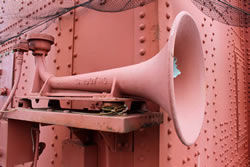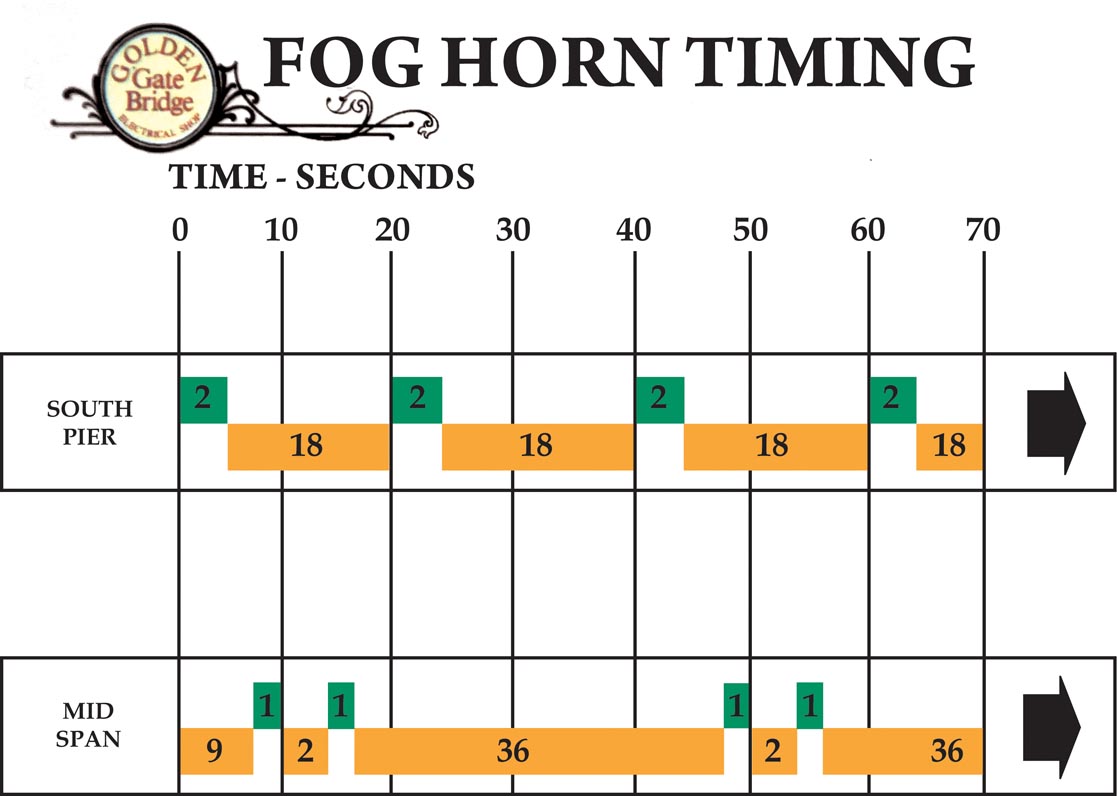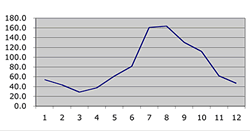
Why does the fog come through the Golden Gate?
It is the only sea-level gap in the coastal mountain range for hundreds of miles. It is a canyon cut through the mountains by an ancient river. Water stored as ice melted as the last Ice Age ended, raising the sea level. Today, the bottom of that canyon is over 300 feet (90 meters) below the waves.
Fog is most common in the summer, when the air over the interior land heats up more than over the ocean. Warm air is less dense and exerts less pressure than cooler air, allowing the cooler ocean air to push its way in through the Golden Gate. Fog is formed when the moist air over the ocean is cooled by cold water currents along Northern California’s coast. The water vapor cools and condenses into tiny water droplets – fog.
More Images
 |
Photo of Bridge foghorn |
 |
Fog Horn Timing Chart - Shows the difference in time intervals of the fog horns at the South Tower of the Bridge and at midspan. The south tower foghorn sounds a deep, loud note for 2 seconds, then it repeats in 18 seconds. Another foghorn at midspan between the towers sounds a pair of high-pitched notes |
 |
Average number of hours of fog since 1937, based on hours of foghorn operation since 1937 (January = month 1)
|
Explore this Topic Further
Fog Horns and Navigational Beacons
Fog Horns from the Golden Gate Bridge Highway & Transportation District (all ages)
This page describes the distinct tones and blast patterns of the fog horns at the mid-span and south tower pier of the Bridge.
Navigational Beacons from the Golden Gate Bridge Highway & Transportation District (all ages)
This web page provides a very brief description of the navigational beacons on the Golden Gate Bridge towers and lighting on the cables, deck, and piers that help direct both sea and air traffic.
Bay Area Fog
Golden Gate Bridge Live Webcam from the Golden Gate 75th Anniversary web site
Check out the live webcam to see if it is foggy at the Golden Gate Bridge right now.
A Brief Introduction to the Weather of the San Francisco Bay Area by Scott W. Starratt, U.S. Geological Survey
This two-page article describes science behind the different seasons in the Bay Area and provides five pages of graphs and tables with monthly mean temperature and precipitation data.
Fog, Steel, Salt, Rust, and Paint from Golden Gate Bridge and Transportation District
This exhibit at the Golden Gate Bridge Visitor Area near the south tower describes how the Bay Area fog corrodes steel requiring continual painting of the Bridge to protect it.
Basics of Sounds Waves
Pitch and Frequency from the Physics Classroom (grades 6 to adult)
This lesson describes how sound pitch is related to the frequency of the vibrations, which is helpful in understanding the science behind the different tones of the foghorns on the Golden Gate Bridge.